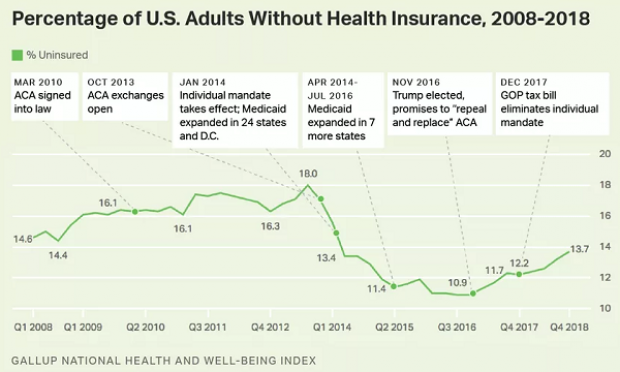The number of Americans lacking health insurance has increased by 7 million since Donald Trump became president, according to data released by Gallup Wednesday.
The uninsured rate – the percentage of adults in the U.S. who say they have no health insurance – has risen steadily under President Trump, reaching 13.7 percent in the fourth quarter of 2018. “While still below the 18% high point recorded before implementation of the Affordable Care Act's individual health insurance mandate in 2014, today's level is the highest in more than four years, and well above the low point of 10.9% reached in 2016,” Gallup’s Dan Witters said.
The 2.8 percentage-point increase in the uninsured rate experienced between the fourth quarter of 2016 and the fourth quarter of 2018 “represents a net increase of about seven million adults without health insurance,” Witters wrote.
Who’s been hit the hardest: The largest increases in the uninsured rate were experienced by women, those in households making less than $48,000 a year, and young adults. About 21 percent of those under the age of 35 now lack health insurance, a nearly 5 percentage-point increase since 2016.
Economic growth isn’t helping as much as usual: Vox’s Sarah Kliff said the trend was surprising given the solid economic growth that has driven the unemployment rate to near-record lows. “Usually, when more people have jobs, it means more people with access to employer-sponsored health insurance. But even during this period of job growth, America’s uninsured rate keeps climbing,” Kliff wrote.
What’s behind the increase: Gallup cites several factors that likely are driving the uninsured rate higher, including:
- rising Obamacare premiums,
- sharply reduced funding for marketing and enrollment outreach,
- repeated efforts by Republicans to repeal the Affordable Care Act, which combined with President Trump’s public declarations that “Obamacare is dead” may have increased uncertainty and reduced enrollment.





